5 Year Solar Energy Farm Finance Model
Here’s a comprehensive breakdown of the Excel Financial Model for a Solar Energy Farm, covering the Income Statement, Cash Flow Statement, and Balance Sheet. With cost structures from electricity sales, subsidies, and grants, these financial statements forecast the financial health of your Solar Farm. 20 Year Model.
Solar Energy Farm Financial Model
Key Components of the Model:
- Revenue Projections – Income from selling electricity via Power Purchase Agreements (PPAs) or Feed-in Tariffs (FiTs).
- Capital Expenditures (CapEx) – Cost of purchasing and installing solar panels, inverters, and infrastructure.
- Operating Expenses (OpEx) – Maintenance, insurance, land lease, and administrative costs.
- Financing Structure – Equity vs. debt financing, loans, and interest payments.
- Tax Incentives & Depreciation – Government incentives, tax credits, and depreciation schedules.
- Financial Statements – Income Statement, Cash Flow Statement, and Balance Sheet.
Income Statement (Profit & Loss Statement)
This statement summarizes revenues, expenses, and profitability over a given period (monthly, quarterly, or annually).
Revenue Section:
- Electricity Sales Revenue – Based on energy produced (MWh) and tariff rates.
- Renewable Energy Credits (RECs) or Carbon Credits – If applicable, revenue from selling environmental attributes.
- Other Incentives/Subsidies – Tax credits, government incentives, or grants.
Cost of Goods Sold (COGS):
- Direct Operating Costs – Includes monitoring, inverter replacements, and cleaning panels.
- Land Lease or Property Taxes – If the land is leased instead of owned.
Operating Expenses (OpEx):
- Operations & Maintenance (O&M) Costs – Regular maintenance, repair, and staff wages.
- Insurance – Coverage for equipment damage, liability, and business interruptions.
- Administrative Costs – Salaries, office expenses, and legal/accounting fees.
Depreciation & Amortization:
- Depreciation of Solar Panels and Equipment – Spread over 5 years.
- Loan Amortization – If applicable, interest and principal payments.
Earnings Calculation:
- EBITDA (Earnings Before Interest, Taxes, Depreciation & Amortization) EBITDA=Revenue−OperatingExpensesEBITDA = Revenue – Operating ExpensesEBITDA=Revenue−OperatingExpenses
- EBIT (Earnings Before Interest & Taxes) EBIT = EBITDA – Depreciation & Amortization
- Net Income (Profit After Taxes & Interest) NetIncome=EBIT−Interest−TaxesNet Income = EBIT – Interest – TaxesNetIncome=EBIT−Interest−Taxes
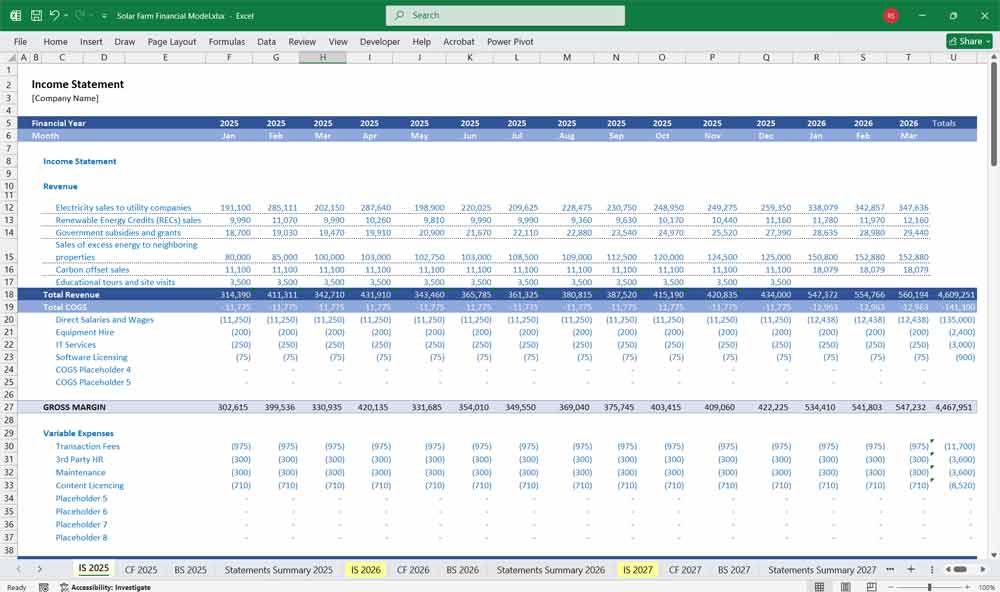
Solar Energy Farm Finance Model Cash Flow Statement
The cash flow statement tracks cash movements in and out of the business, ensuring liquidity management.
Cash Flow from Operating Activities:
- Net Income (from the Income Statement)
- Adjustments for Depreciation & Amortization (non-cash expense)
- Changes in Working Capital (Receivables, Payables, Inventory)
Cash Flow from Investing Activities:
- Initial CapEx – Purchase of solar panels, inverters, transmission equipment.
- Replacement Costs – Future investments in upgrading or replacing equipment.
Cash Flow from Financing Activities:
- Equity Investment – Capital raised from investors.
- Debt Financing – Loans taken, including repayment schedules.
- Dividend Payments – If profits are distributed to shareholders.
Net Cash Flow Calculation:
Net Cash Flow = Operating Cash Flow + Investing Cash Flow + Financing Cash Flow Net \ Cash \ Flow = Operating Cash Flow + Investing Cash Flow + Financing Cash Flow Net Cash Flow = Operating Cash Flow + Investing Cash Flow + Financing Cash Flow
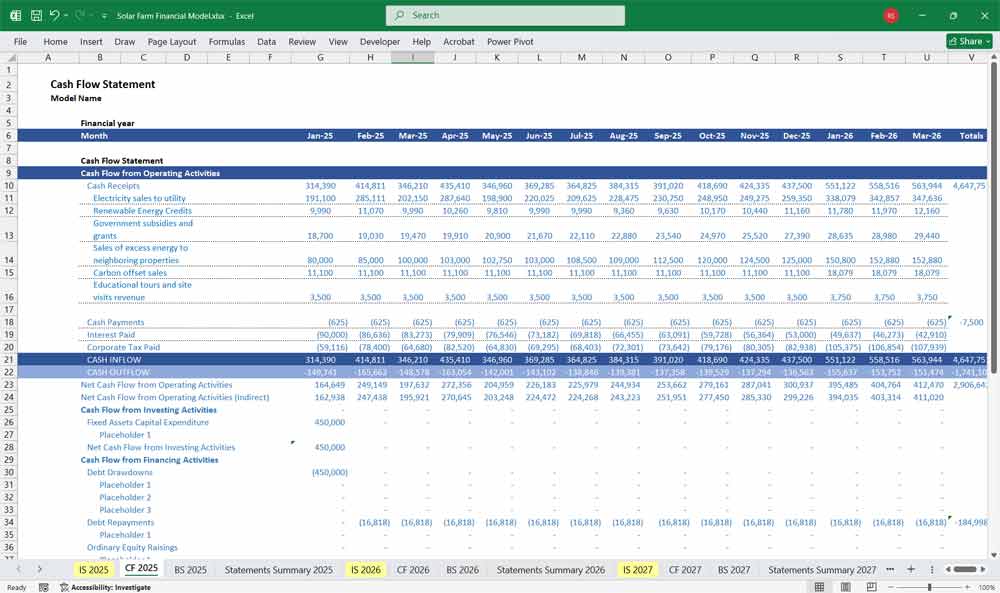
Solar Energy Farm Finance Model Balance Sheet
The balance sheet provides a snapshot of the solar farm’s financial position, including assets, liabilities, and equity.
Assets:
Current Assets:
- Cash & Cash Equivalents – Working capital liquidity.
- Accounts Receivable – Unpaid invoices from electricity buyers (utility companies or corporate clients).
Non-Current Assets:
- Property, Plant & Equipment (PP&E) – Solar panels, inverters, and site infrastructure.
- Land (if owned) – If the solar farm owns the land instead of leasing.
Liabilities:
Current Liabilities:
- Accounts Payable – Short-term obligations to suppliers.
- Short-Term Loans – Portion of long-term debt due within a year.
Long-Term Liabilities:
- Long-Term Loans – Debt used for financing the project.
- Deferred Tax Liabilities – Due to accelerated depreciation tax benefits.
Equity:
- Owner’s Equity/Retained Earnings – Capital contributed by shareholders and accumulated profits.
Balance Sheet Equation:
Assets = Liabilities + Equity Assets = Liabilities + Equity Assets = Liabilities + Equity
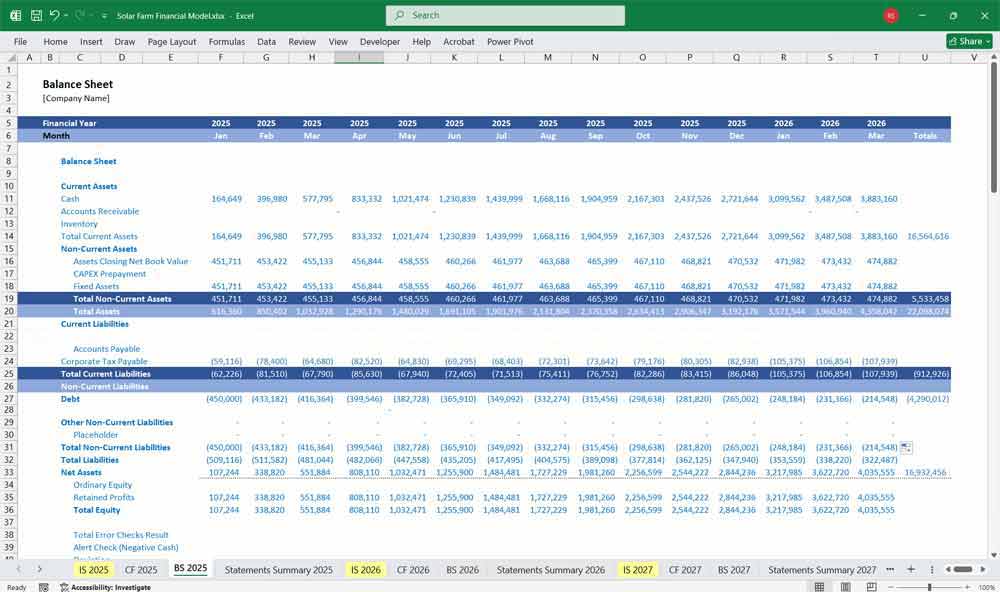
Key Financial Metrics for a Solar Energy Farm
- Gross Profit Margin = (Gross Profit / Revenue) × 100
- Operating Profit Margin (EBIT Margin) = (EBIT / Revenue) × 100
- Net Profit Margin = (Net Income / Revenue) × 100
- Return on Assets (ROA) = (Net Income / Total Assets) × 100
- Return on Equity (ROE) = (Net Income / Shareholder Equity) × 100
- Debt-to-Equity Ratio = (Total Debt / Shareholder Equity)
- Inventory Turnover = (COGS / Average Inventory)
- Days Revenue Outstanding (DRO) = (Accounts Receivable / Revenue) × 365
Financial Benefits for a Solar Energy Farm
Solar Energy Cost Savings
Solar reduces electricity bills significantly over time.
Lowers operational costs due to minimal maintenance requirements.
Solar Energy Provides protection against rising energy prices.
Solar Energy Offers long-term financial stability through fixed energy costs.
Solar Energy is Eligible for various tax incentives and rebates.
Solar Energy Revenue Generation
Solar Farms sell excess energy back to the grid through net metering.
Solar Energy generates income through Renewable Energy Certificates (RECs).
Solar Energy attracts investors seeking sustainable and profitable ventures.
Creates opportunities for community solar programs.
Enhances property value with renewable energy installations.
Solar Energy Environmental Benefits
Solar energy reduces carbon footprint by lowering greenhouse gas emissions.
Solar Energy decreases reliance on fossil fuels, promoting cleaner air.
Contributes to global efforts to combat climate change.
Preserves natural resources by using renewable energy.
Solar supports biodiversity by minimizing land disruption.
Solar Energy Independence
Solar power reduces dependence on external energy suppliers.
Solar provides a reliable energy source during grid outages.
Solar Farms enhance national energy security by utilizing local resources.
Encourages decentralized energy production.
Mitigates risks associated with energy price volatility.
Solar Energy Scalability
Solar power can be expanded easily to meet growing energy demands.
Solar is suitable for both small-scale and large-scale applications.
Solar power is Adaptable to various geographic locations and climates.
Modular design allows for incremental investment.
Solar supports hybrid energy systems for increased efficiency.
Solar Energy Job Creation
Solar Farms generate employment opportunities in construction and installation.
Solar Energy generates long-term jobs in maintenance and operations.
Solar supports local economies through renewable energy projects.
Encourages skill development in the green energy sector.
Solar Energy attracts a diverse workforce, including engineers and technicians.
Solar Energy Technological Advancements
Drives innovation in solar panel efficiency and storage solutions.
Encourages research and development in renewable energy.
Solar Farms facilitate the integration of smart grid technologies.
Promotes advancements in energy management systems.
Supports the development of next-generation solar technologies.
Solar Energy & Government Support
Eligible for federal and state tax credits.
Qualifies for grants and subsidies aimed at renewable energy.
Benefits from favorable regulatory policies.
Solar Farms receive support through renewable energy mandates.
Encourages public-private partnerships for sustainable development.
Solar Energy Community Benefits
Solar Energy provides clean energy access to underserved communities.
Solar Farms reduce energy poverty by lowering electricity costs.
Enhances public health by reducing air pollution.
Solar Energy promote environmental awareness and education.
Solar Energy Farms encourage community involvement in sustainability initiatives.
Solar Energy Risk Mitigation
Diversifies energy sources, reducing reliance on a single provider.
Solar Energy minimizes exposure to fuel price fluctuations.
Provides a hedge against future energy regulations.
Solar Energy reduces operational risks associated with traditional energy sources.
Ensures long-term energy price predictability.
Solar energy & Corporate Social Responsibility (CSR)
Demonstrates commitment to sustainability and environmental stewardship.
Solar energy enhances brand reputation and public image.
Solar attracts environmentally conscious customers and investors.
Solar aligns with global sustainability goals (e.g., UN SDGs).
Encourages industry leadership in renewable energy adoption.
Energy Storage Integration
Enhances grid stability through battery storage systems.
Solar Energy provides backup power during peak demand periods.
Maximizes energy utilization by storing excess production.
Solar Farms support off-grid applications in remote areas.
Facilitates the transition to a more resilient energy infrastructure.
Solar & Low Operating Costs
Solar Farms require minimal maintenance compared to traditional power plants.
Has no fuel costs, as sunlight is free and abundant.
Solar Farms reduce water usage, unlike conventional energy sources.
The long lifespan of solar panels ensures consistent performance.
Lower insurance costs due to reduced operational risks.
Solar Energy Global Market Potential
Access to growing international demand for renewable energy.
Solar Knowledge offers opportunities for the export of solar technology and expertise.
Solar Energy attracts foreign investment in sustainable infrastructure.
Supports global energy transition initiatives.
Enhances competitiveness in the global renewable energy market.
Solar Energy Resilience to Climate Change
Less vulnerable to extreme weather events compared to fossil fuel infrastructure.
Provides reliable energy in regions prone to natural disasters.
Solar Energy reduces strain on water resources, which are critical during droughts.
Supports climate adaptation strategies through clean energy.
Solar Energy uptake contributes to reducing the overall impact of climate change.
Solar Energy & Educational Opportunities
Solar Farms provide hands-on learning experiences for students and researchers.
Encourages academic institutions to develop renewable energy programs.
Solar Farms can support workforce training in emerging green technologies.
Facilitates partnerships between universities and industry.
Promotes STEM education through renewable energy projects.
Solar Energy Efficiency
Converts sunlight directly into electricity with high efficiency.
Reduces energy losses associated with long-distance transmission.
Supports the use of energy-efficient appliances and systems.
Solar power enhances overall energy productivity.
Encourages the adoption of energy-saving practices.
Solar Energy Public Health Benefits
Solar Farms reduce respiratory illnesses by decreasing air pollution.
Solar Energy lowers healthcare costs associated with fossil fuel emissions.
Improves quality of life in urban and rural areas.
Decreases the incidence of heat-related illnesses by mitigating climate change.
Solar Farms promote overall well-being through cleaner environments.
Solar Farms & Innovative Financing Models
Enables power purchase agreements (PPAs) for cost-effective energy.
Supports green bonds and other sustainable investment instruments.
Solar Financial Models facilitate easier crowdfunding for community solar projects.
Encourages leasing options for solar installations.
Attract venture capital for renewable energy startups.
Solar Energy & Long-Term Investment
Provides a stable return on investment over decades.
Solar offers predictable cash flows through energy sales.
Enhances portfolio diversification for investors.
Supports sustainable economic growth.
Solar Energy Farms ensure energy security for future generations.
Public-Private Partnerships (PPPs) in solar energy projects offer a collaborative framework where government entities and private sector companies share resources, risks, and rewards to develop sustainable energy infrastructure. These partnerships help reduce the financial burden on public institutions by leveraging private capital while providing investors with stable, long-term returns backed by public support. PPPs also accelerate project development through streamlined processes and shared expertise, enhancing efficiency and innovation. By aligning public interests with private sector efficiency, PPPs foster knowledge transfer, encourage community engagement, and promote energy resilience. Ultimately, they create a balanced investment model that delivers economic, social, and environmental benefits.
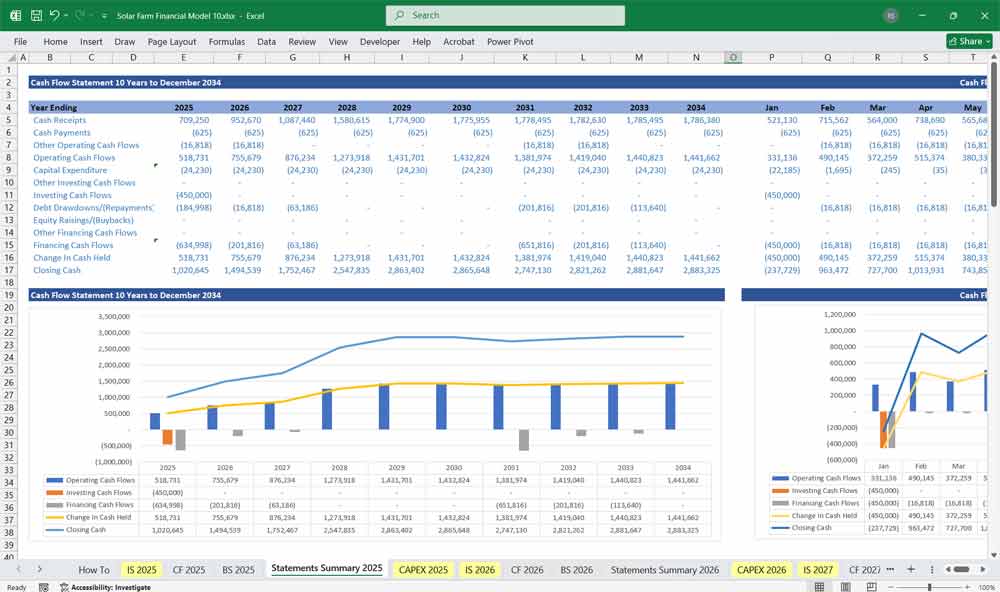
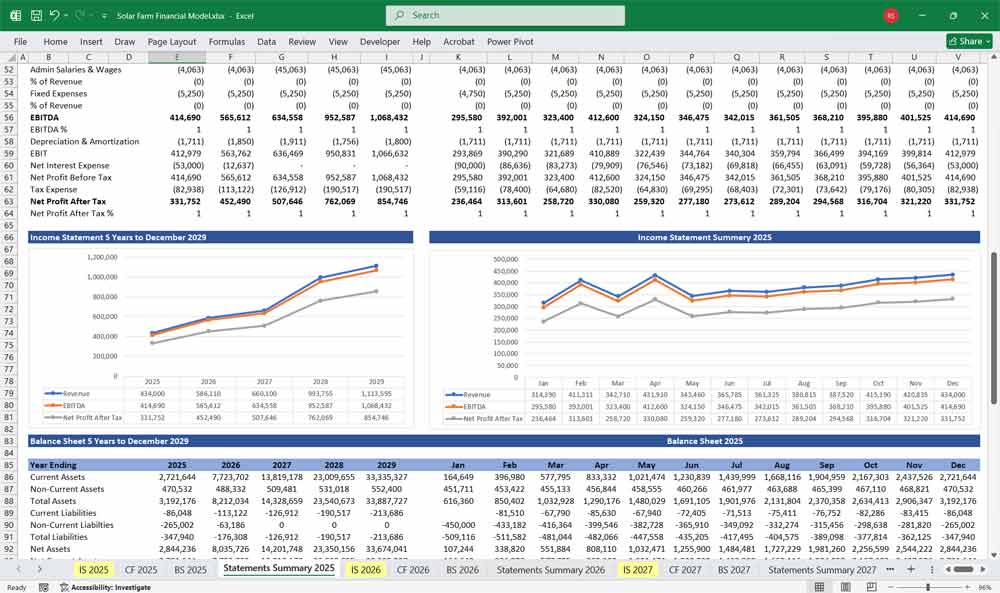
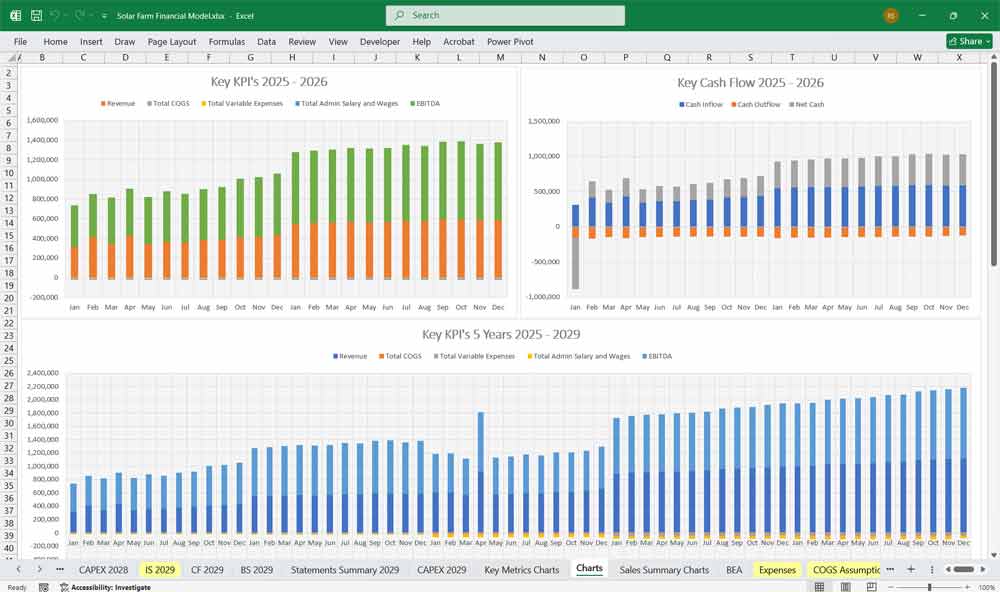
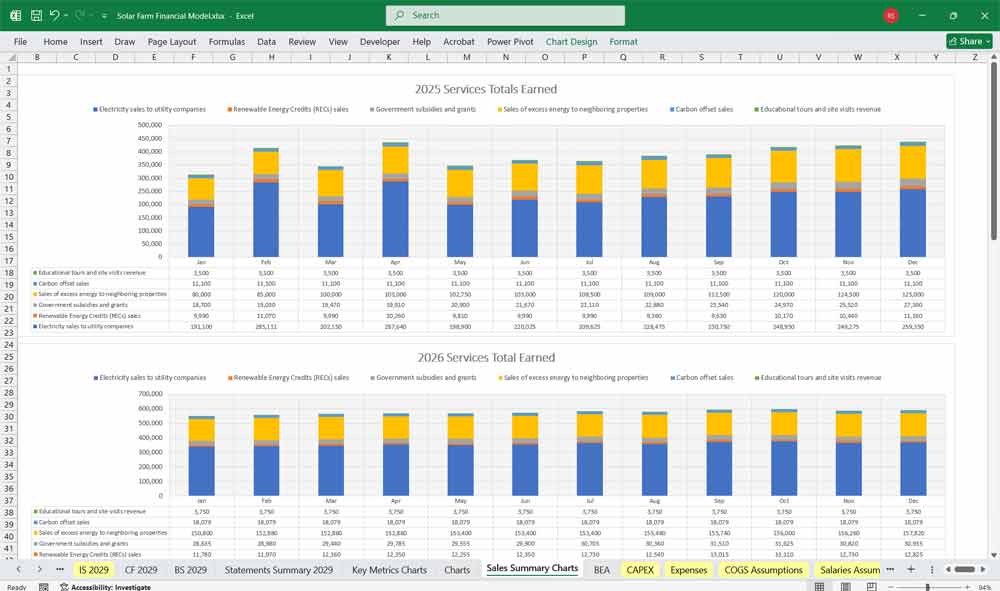
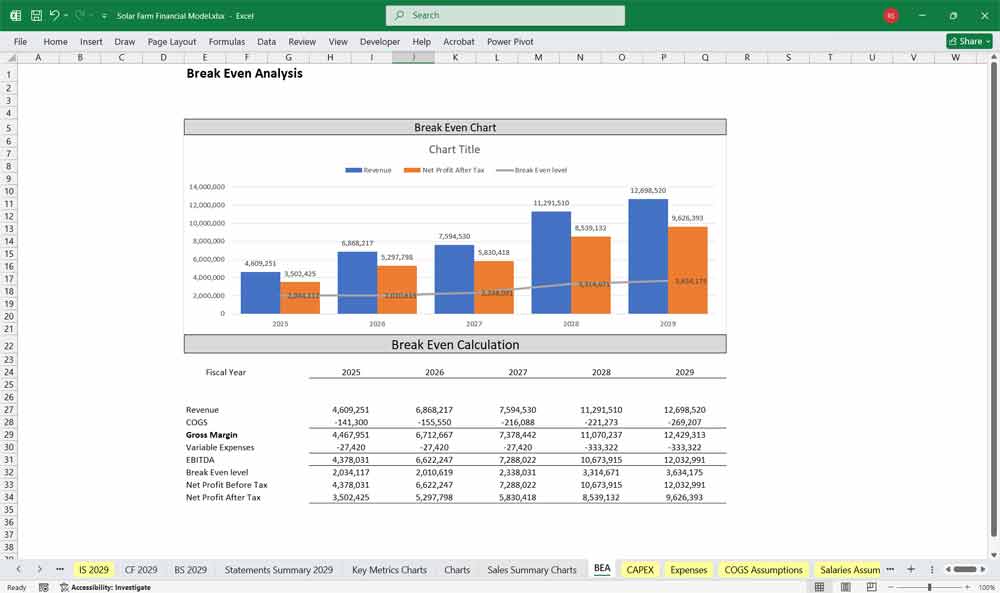
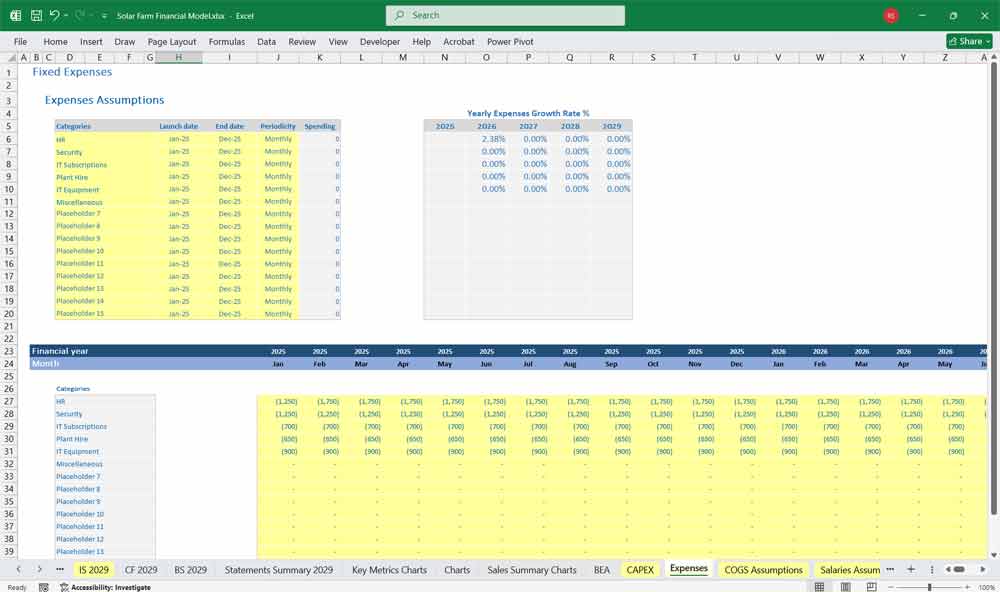
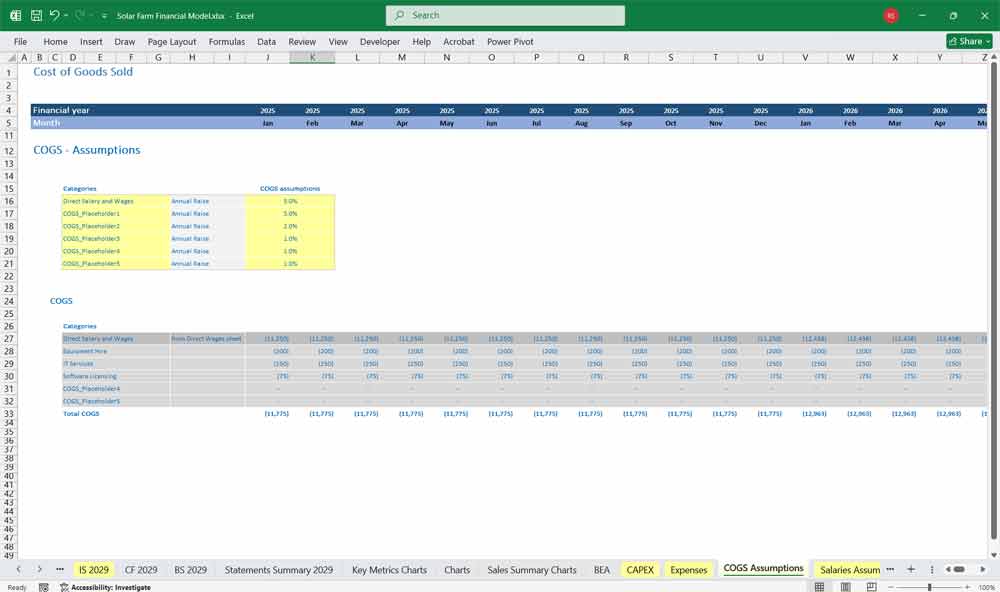
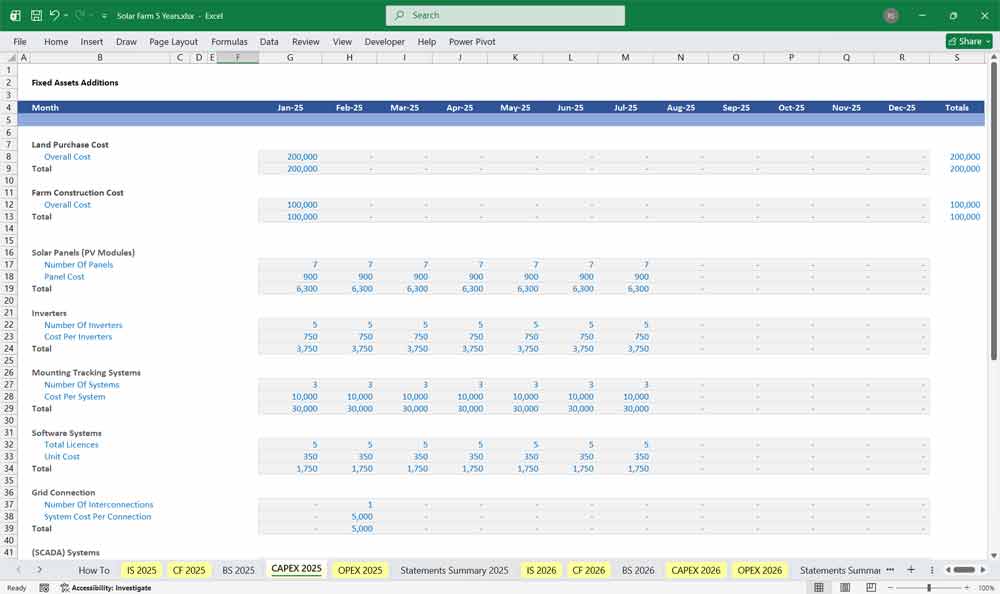
Final Notes on the Financial Model
Financial Model for a Solar Energy Farm
- Scenario Analysis: Create best-case, base-case, and worst-case projections.
- Break-even Analysis: Determine sales volume required to cover fixed & variable costs.
- Sensitivity Analysis: Assess how changes in raw material costs, pricing, or demand impact profitability.
This 5-year financial model provides a structured way to analyze the profitability and sustainability of a solar farm. Investors and lenders will closely examine these financial statements to assess risks and returns before committing to funding.
Download Link On Next Page
